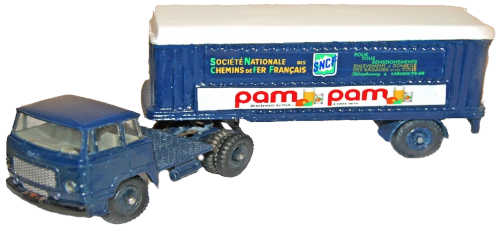SNCF: off the rails
by John Morris
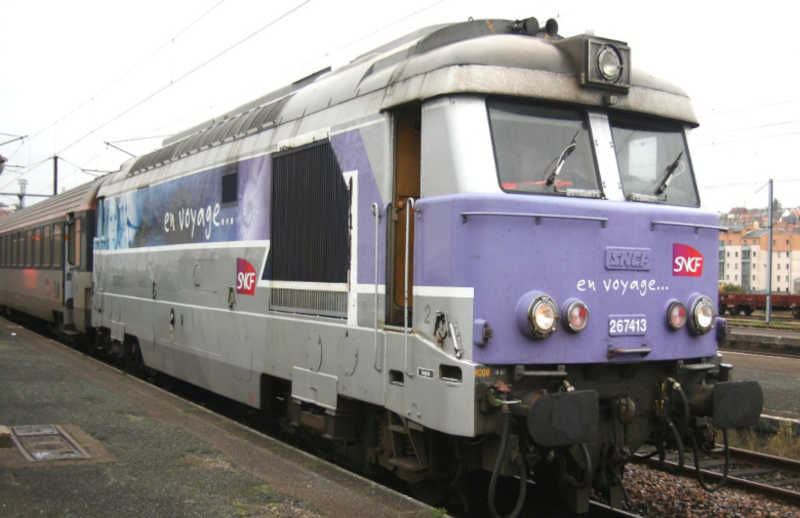
Founded in 1938, The Société Nationales des Chemins de fer Francais (SNCF) operates France’s state-owned railway company. Headquartered in the Parisian suburb of St. Denis, the company that manage the road of iron (Chemins de fer), structure its organization into five divisions. ‘SNCF Voyages’ provides passenger transport. While ‘SNCF Logistics’ runs the freight transport section, which has a long and distinguished history of collecting and delivering customer’s baggage and other goods. French Dinky modelled three trucks to reflect the importance of SNCF’s off rail activities.
In 1949, when the production of French Dinky Toys restarted after the Second World War, they introduced model 25JJ based on the pre-war Ford ‘Poissy’, named after the Paris suburb where the vehicle was built. The introduction of models based on this out-dated vehicle was an attempt to re-establish French culture, rather than remind children of wartime defeat and the post-war reliance on army surplus vehicles. For example, the 25 series trucks used a casting of a wartime Studebaker pick-up. Models of the Ford vehicle were at a 1:65 scale and came as one of three types, the long 102mm version, the short 95 mm type and the monocoque 25U, used solely for the Esso tanker. The SNCF version, along with the model in the Calberson livery, were of the longer 102mm type. Calberson are a public haulage company and, as SNCF Geodis, are now a part of SNCF Logistics.
The initial proto-type, which was not for commercial production, had most of the features used in the production model, including the SNCF logo, with the steam train on a map of France and the letters SNCF reflected in the styling of the train’s boiler. Early 1949- 50 models had metal wheels and tyres due to the shortage of rubber available within the French economy. The mid-blue casting, with its midnight blue tinplate canopy, cost fr.180.00 (old Francs), about 3s.6d.
In late 1950, smooth rubber type M type tyres on ribbed hubs became the model’s first modification. Between 1951 and 1952, a steel hook was attached at the rear of the truck. The cost of this model increased to fr. 185.00, about 3s. 9d. French Dinky withdrew the SNCF truck during 1954, with the Calberson version making its final appearance in the 1952 French Dinky catalogue.
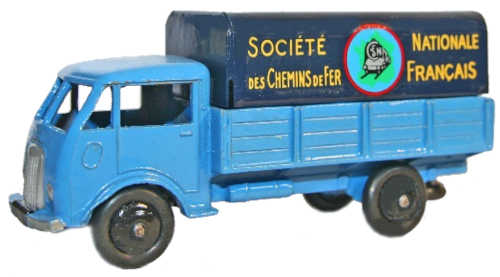
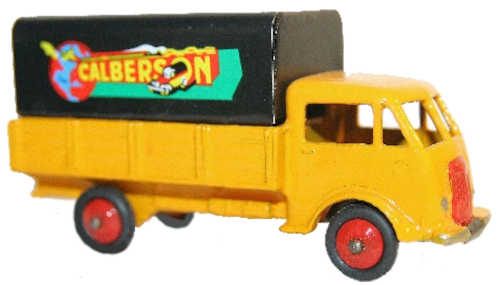
Shown in the 1953 French Dinky catalogue, a prototype of model 32Ba, the 165mm, 1/60 scale, SNCF Panhard Movic tractor and articulated tarpaulin covered, non-detachable trailer, was in production. Not sold commercially, the midnight blue unit had the screen printed logo of SNCF on a light green background around a map of France within a red circle. The tinplate used to represent the tarpaulin carried the full name of SNCF, the national railway, in green. The interior roof of the tractor cab is smooth and the base plate is also tinplate, stamped with Dinky Toys, made in France and Meccano. The words ‘Panhard Tractor’ are built into the casting, which was mounted on axles with ribbed hubs and smooth cylindrical tyres.
In April 1954, when French Dinky launched the model, they were sold individually, but came in trade boxes of three and each model cost fr.485.00, about 8s 6d. Much remained the same as in the prototype, although the baseplate of the tractor chassis was now crimped.
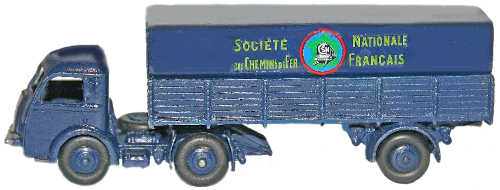
At the end of 1954, French Dinky introduced the first major changes to the model. The interior of the tractor cab remained smooth as were the cylindrical tyres. The big modification was to up-date the SNCF logo on the tarpaulin cover, which was now of the badge type, with a map of France mounted on a light green background. When the background to the map of France changed from the light yellowish green to dark green, it seems that the roof interior of the tractor cab became the checkered type. The SNCF company name was emblazoned in old gold lettering on either side of the badge.
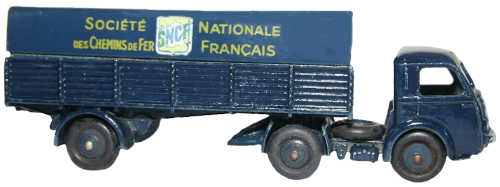
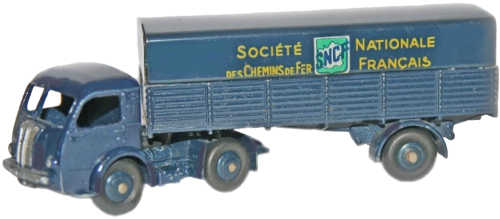
In 1959, with the third iteration being re-numbered as 575, cost fr. 570 (old francs), about 10/6. Now, the model came in individual yellow boxes. The boxes’ artwork shows the vehicles logo on a yellow background, which appears to have given rise to the logo appearing in restoration products. Often described as second issue, the golden background to the map may be a misinterpretation of the earlier pale yellowish green.
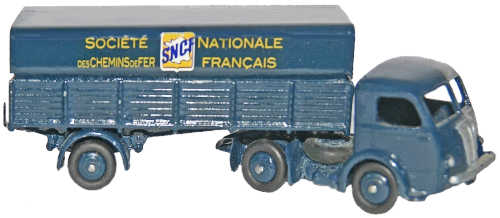
In 1961, the fourth version of the model, renumbered as 575, remained at the 1/60 scale, but now cost fr. 6.0 (new francs), which increased to fr.7.00 in 1963, about 14/-. The Panhard Movic tractor tows a semi-trailer with tarpaulins, armed with SNCF logo and name, with the first letter of each key word shown in green. The SNCF screen-printed markings are of the badge-type, with a map of France on a light green background. The 1963 version, 575Bb, retained the badge-type logo, but had the green background displayed on a blue grid of squares. The trailer cover is made of sheet metal, the chassis baseplate is also made of sheet metal. The undercarriage of the tractor is now grid, a chassis reinforcement appears on the underside of the trailer, at the axle. The blue metal hubs are fitted with cylindrical tyres. Later versions replaced the convex hubs with concave ones. Although this model was first available in a box of three, these were soon replaced by individual yellow cardboard boxes. Introduced in 1955, the last time the model appeared in a French Dinky catalogue was 1963 and French dinky withdrew the model in 1964.
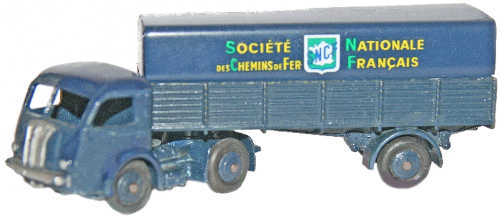
In recent times, a new reproduction of the tarpaulin cover has emerged. In black, the cover displays the logos of SNCF and Calberson, no doubt to reflect the creation of SNCF logistics.
In 1966, French Dinky launched the Unic Estrel tractor, with a SNCF articulated trailer. Known as the Pam Pam model, after the bold advertisement of a French orange juice brand. The 255mm long model, at a 1:55 scale was in moulded zamak, with sheet metal floors and a cream plastic roof on the trailer, which was fastened with clips. In Dinky catalogues, the trailer was always shown with a marine blue roof and with its over-sized proportions gave rise to the suggestion that the trailer was better suited to the French FAR tractor unit, for which it was used in reality. The FAR tractor had a similar design to the Mechanical Horse or Scammell Scarab and was subsequently produced as a model by Corgi.
The Unic’s glazed tractor had a grey plastic interior and a black two branch steering wheel. The trailer had a grey plastic stand, which frequently become brittle over time and often breaks, but can easily be replaced by purchasing a replacement from Steve Flowers. At the rear of the trailer, a white roller shutter comes down onto a detachable tailgate. The tailgate is often missing and a replacement can also be acquired from Steve. The shutter too frequently becomes fragile or damaged and, if it needs to be replaced, ‘Hobbycraft’ supply corrugated plastic sheeting that can be cut to size. The model comes with large notched black tyres, which are on plastic hubs. Costing fr.22.50 (new francs), about 18/-, French Dinky withdrew the model in 1969.
